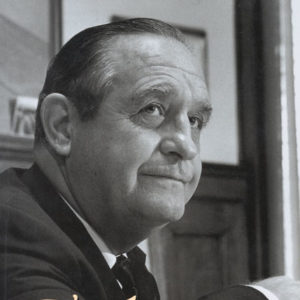calsfoundation@cals.org
Roy Reed (1930–2017)
Roy Reed, author of an incisive biography of Governor Orval Faubus, was a renowned writer and reporter for the Arkansas Gazette and The New York Times. He taught journalism for sixteen years at the University of Arkansas (UA) in Fayetteville (Washington County). As a teacher, he stressed not only the importance of telling stories accurately but of telling them well, with careful attention to language.
Roy Reed was born on February 14, 1930, in Hot Springs (Garland County) to Roy E. Reed, a mail carrier and later a storeowner, and Ella Meredith Reed, a homemaker. His younger sister, Hattie, died in 1964.
Reed grew up in Piney, an unincorporated Garland County community near Hot Springs. Piney was racially mixed, and Reed, who later covered civil rights for the Times, got what he described as his “first exposure to the race issue” from his father’s African-American customers. Two men in particular helped him understand the wounds inflicted on black Americans by racial discrimination, he said: one was a World War II veteran who retuned to the states angry that black Americans did not enjoy the same civil rights he had fought to defend, while the other had managed to find a place in the existing political system and worked alongside Reed’s father to turn out Piney’s voters, black and white, for favored candidates.
Reed graduated from Lakeside High School in 1947 and attended Ouachita Baptist College (now Ouachita Baptist University) in Arkadelphia (Clark County) for a year. He then attended the University of Missouri, where he earned a bachelor’s degree in journalism in 1951 and an MA in journalism in 1954. He worked for about a year, in 1953, as a reporter for the Joplin, Missouri, Globe.
On February 3, 1952, he married Norma Pendleton of El Dorado (Union County). They had two children, Cindy and John.
After two years in the U.S. Air Force, Reed went to work as a reporter for the Arkansas Gazette in 1956. He did not take part in the paper’s coverage of the desegregation crisis at Central High School in Little Rock (Pulaski County) but reported on an unsuccessful attempt by black students to enroll in North Little Rock’s white high school. He was later assigned to the state Capitol and covered the Faubus administration. He attended Harvard as a Nieman fellow in 1963–64, studying Southern populism and socialism, and was hired by The New York Times in January 1965 to cover the South. The civil rights movement was heating up, and he was quickly dispatched to Selma, Alabama, where he covered the historic Freedom March to the state Capitol in Montgomery in March 1965.
Reed spent the rest of 1965 and 1966 reporting on the civil rights movement, a period he later called “two of the most exciting years of my working life.” He joined the Times’s White House bureau in 1967 but soon found his assignment confining. In 1968, he began a two-year stint writing about the civil rights movement as it involved federal agencies in Washington. Late in the summer of 1969, he opened a Times bureau in New Orleans and, for the next seven years, chronicled the rapid social, political and economic changes in the South and other parts of the nation.
In 1976, Reed transferred to the Times’s London bureau, where he spent his final two years with the paper covering the British Isles. He moved back to Arkansas in December 1978 and commissioned the architect E. Fay Jones to design a house for him on a small farm in Hogeye (Washington County). Throughout his academic career, which ended with his retirement from the UA journalism department in 1995, he continued to write occasional pieces for newspapers and magazines. In 1986, he published Looking for Hogeye, a collection of essays about the South. Faubus: The Life and Times of an American Prodigal, his biography of the former governor, was published in 1997. Reed concluded that Faubus, once a liberal on matters of race, tried to block the integration of Central High because he feared that doing otherwise would end his political career. Faubus was a New York Times Notable Book for 1997.
In 2009, he published the edited volume Looking Back at the Arkansas Gazette: An Oral History. The following year, he was awarded the Porter Prize. In 2012, he published the memoir Beware of Limbo Dancers: A Correspondent’s Adventures with the New York Times. In the 2014 movie Selma, he was played by actor John Lavelle.
Reed died in Fayetteville on December 10, 2017, following a stroke.
For additional information:
Arkansas Gazette Project. David and Barbara Pryor Center for Arkansas Oral and Visual History. University of Arkansas Libraries, Fayetteville, Arkansas. Online at http://pryorcenter.uark.edu/project.php?projectFolder=Arkansas%20Gazette&thisProject=2&projectdisplayName=Arkansas%20Gazette%20Project (accessed July 19, 2023).
Reed, Roy. Beware of Limbo Dancers: A Correspondent’s Adventures with the New York Times. Fayetteville: University of Arkansas Press, 2012.
Robert, Gene, and Hank Klibanoff. The Race Beat: The Press, the Civil Rights Struggle, and the Awakening of a Nation. New York: Knopf, 2006.
Schwartz, John. “Roy Reed, Times Reporter Who Covered the Civil Rights Era, Dies at 87.” New York Times, December 11, 2017. Online at https://www.nytimes.com/2017/12/11/obituaries/roy-reed-dead.html (accessed July 19, 2023).
Scott Morris
North Little Rock, Arkansas
 Arts, Culture, and Entertainment
Arts, Culture, and Entertainment Civil Rights and Social Change
Civil Rights and Social Change Divergent Prosperity and the Arc of Reform, 1968–2022
Divergent Prosperity and the Arc of Reform, 1968–2022 Literature and Authors
Literature and Authors Mass Media
Mass Media Faubus: The Life and Times of an American Prodigal by Roy Reed
Faubus: The Life and Times of an American Prodigal by Roy Reed  Roy Reed
Roy Reed 




I have read his biography of Faubus. WOW! What insight! Being his student would have, indeed, been inspirational.
Roy Reed was my professor and instructor at the University of Arkansas School of Journalism. He was wonderful. I used to “run” to his class, and enter out of breath. Roy would just smile.
What Roy Reed taught me has served me for many years in many ways. In my mind, he remained a true gentleman and a first-rate scholar who never lost his sense of humor.